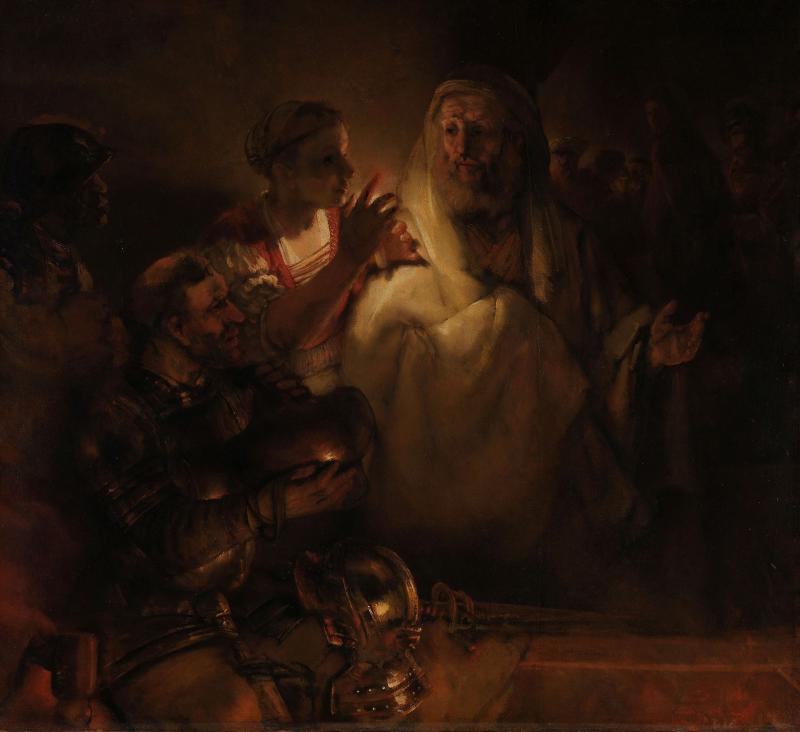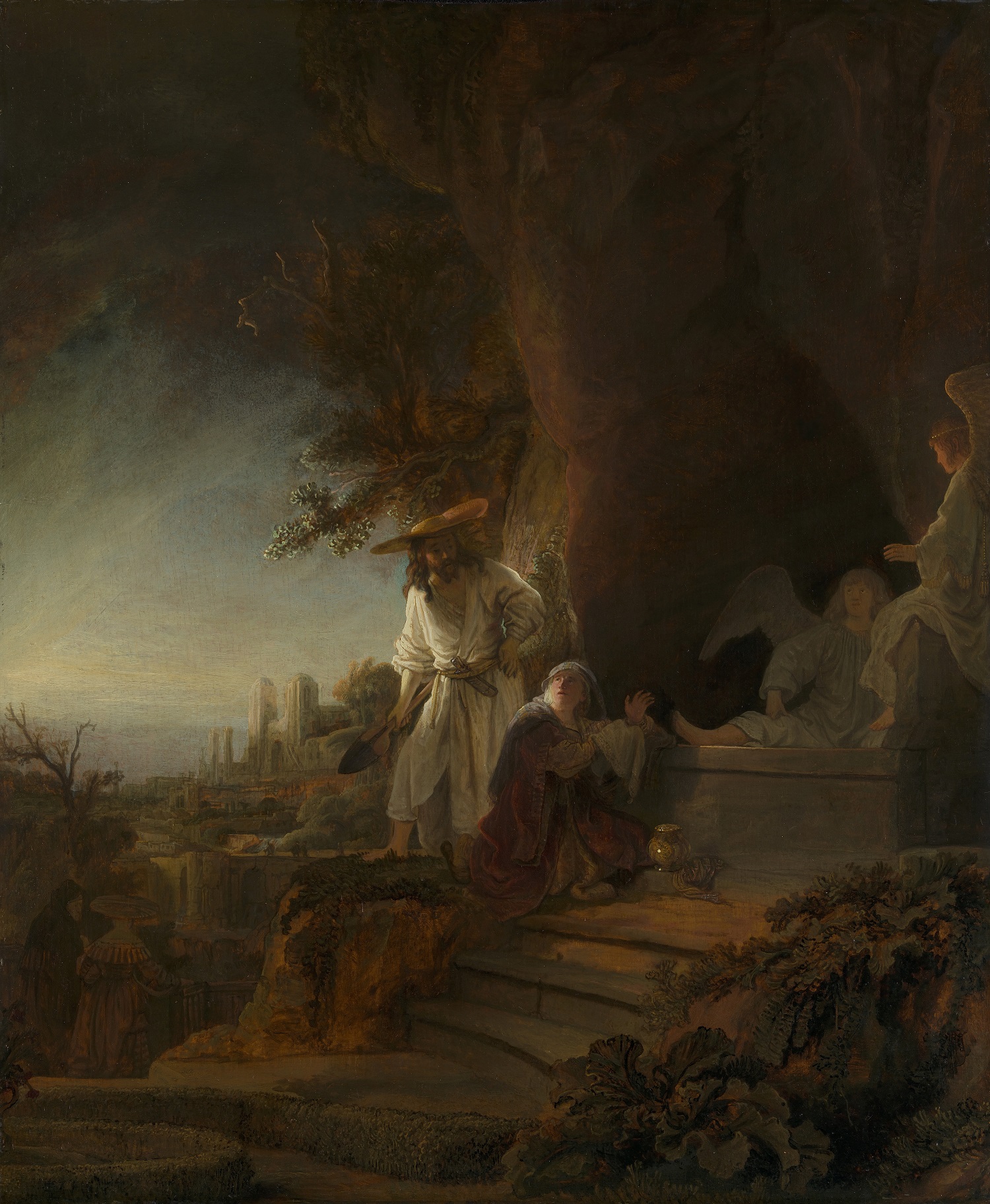Rembrandt's Light, Dulwich Picture Gallery review - a film-maker out of time? | reviews, news & interviews
Rembrandt's Light, Dulwich Picture Gallery review - a film-maker out of time?
Rembrandt's Light, Dulwich Picture Gallery review - a film-maker out of time?
A novel collaboration between curators and cinematographer Peter Suschitzky

Among the numerous exhibitions marking the 350th anniversary of Rembrandt’s death, this small show at the Dulwich Picture Gallery stands out.
Perhaps if Rembrandt were alive today he might have chosen film over paint. It’s not such a radical proposal, and follows on from Peter Greenaway’s 2010 film which presented Rembrandt’s masterpiece The Night Watch, 1642, as the first work of cinema.
 Certainly, Rembrandt had a film-maker’s feel for mise-en-scene. Sometimes he comes in close, cropping a scene to intensify its drama and draw us into the action (Main picture: The Denial of St Peter, 1660); sometimes he moves out, arousing our pity for the Woman Taken in Adultery, 1644, who is small and vulnerable against a massive architectural setting.
Certainly, Rembrandt had a film-maker’s feel for mise-en-scene. Sometimes he comes in close, cropping a scene to intensify its drama and draw us into the action (Main picture: The Denial of St Peter, 1660); sometimes he moves out, arousing our pity for the Woman Taken in Adultery, 1644, who is small and vulnerable against a massive architectural setting.
Apparently, he got his students to act out scenes before they began painting them. From this, they would have learned to direct and modulate light to make big gestures redundant, drawing the viewer’s eye to the tiniest gesture or most fleeting facial expression. Rembrandt’s own explorations in this vein are fascinating: the flash-of-light theatrics of his drawing The Pilgrims at Emmaus, c.1640-1, yield to a subtler treatment of the same subject eight years later, when Christ’s holy light gently illuminates the faces and hands of his two astonished disciples.
The point is made in picture captions that read like stage directions and galleries that serve as stage sets. Lit by cinematographer Peter Suschitzky, they evoke shifting moods and times of day in Rembrandt’s house on Sint-Anthonistbreestraat, bought for far too much money in 1639 and sold by the authorities in 1658 when he was declared bankrupt.
Here, large windows let in a cool, even light which he could direct and diffuse with fabric and shutters. His pupils were taught here, and Rembrandt, clearly a rather progressive teacher, set challenges for them in which they had to depict the effects of different light sources – firelight, candlelight, daylight, holy light.
In our electrified world, the shift from day to night seems rather less ineluctable, to which this exhibition offers something of a corrective. The transformative effects of light are impressively evident in the display of Christ and St Mary Magdalen at the Tomb, 1638 (Pictured above right). It’s a painting that has darkened over time, but expertly lit, it becomes jewel-like. The lesson is a valuable one, and is currently being put into practice at the Rijksmuseum, where analysis of the pigments present in The Night Watch will serve as a guide for the future lighting of the picture: a non-invasive and completely reversible approach to retrieving something of its 17th century condition.
- Rembrandt's Light at Dulwich Picture Gallery until 2 February 2020
- More visual arts reviews on theartsdesk
rating
Explore topics
Share this article
The future of Arts Journalism
You can stop theartsdesk.com closing!
We urgently need financing to survive. Our fundraising drive has thus far raised £49,000 but we need to reach £100,000 or we will be forced to close. Please contribute here: https://gofund.me/c3f6033d
And if you can forward this information to anyone who might assist, we’d be grateful.

Subscribe to theartsdesk.com
Thank you for continuing to read our work on theartsdesk.com. For unlimited access to every article in its entirety, including our archive of more than 15,000 pieces, we're asking for £5 per month or £40 per year. We feel it's a very good deal, and hope you do too.
To take a subscription now simply click here.
And if you're looking for that extra gift for a friend or family member, why not treat them to a theartsdesk.com gift subscription?
more Visual arts
 'We are bowled over!' Thank you for your messages of love and support
Much-appreciated words of commendation from readers and the cultural community
'We are bowled over!' Thank you for your messages of love and support
Much-appreciated words of commendation from readers and the cultural community
 Edward Burra, Tate Britain review - watercolour made mainstream
Social satire with a nasty bite
Edward Burra, Tate Britain review - watercolour made mainstream
Social satire with a nasty bite
 Ithell Colquhoun, Tate Britain review - revelations of a weird and wonderful world
Emanations from the unconscious
Ithell Colquhoun, Tate Britain review - revelations of a weird and wonderful world
Emanations from the unconscious
 Rachel Jones: Gated Canyons, Dulwich Picture Gallery review - teeth with a real bite
Mouths have never looked so good
Rachel Jones: Gated Canyons, Dulwich Picture Gallery review - teeth with a real bite
Mouths have never looked so good
 Yoshitomo Nara, Hayward Gallery review - sickeningly cute kids
How to make millions out of kitsch
Yoshitomo Nara, Hayward Gallery review - sickeningly cute kids
How to make millions out of kitsch
 Hamad Butt: Apprehensions, Whitechapel Gallery review - cool, calm and potentially lethal
The YBA who didn’t have time to become a household name
Hamad Butt: Apprehensions, Whitechapel Gallery review - cool, calm and potentially lethal
The YBA who didn’t have time to become a household name
 Bogancloch review - every frame a work of art
Living off grid might be the meaning of happiness
Bogancloch review - every frame a work of art
Living off grid might be the meaning of happiness
 Do Ho Suh: Walk the House, Tate Modern review - memories are made of this
Home sweet home preserved as exquisite replicas
Do Ho Suh: Walk the House, Tate Modern review - memories are made of this
Home sweet home preserved as exquisite replicas
 Ed Atkins, Tate Britain review - hiding behind computer generated doppelgängers
Emotions too raw to explore
Ed Atkins, Tate Britain review - hiding behind computer generated doppelgängers
Emotions too raw to explore
 Echoes: Stone Circles, Community and Heritage, Stonehenge Visitor Centre review - young photographers explore ancient resonances
The ancient monument opens its first exhibition of new photography
Echoes: Stone Circles, Community and Heritage, Stonehenge Visitor Centre review - young photographers explore ancient resonances
The ancient monument opens its first exhibition of new photography
 Hylozoic/Desires: Salt Cosmologies, Somerset House and The Hedge of Halomancy, Tate Britain review - the power of white powder
A strong message diluted by space and time
Hylozoic/Desires: Salt Cosmologies, Somerset House and The Hedge of Halomancy, Tate Britain review - the power of white powder
A strong message diluted by space and time

Add comment